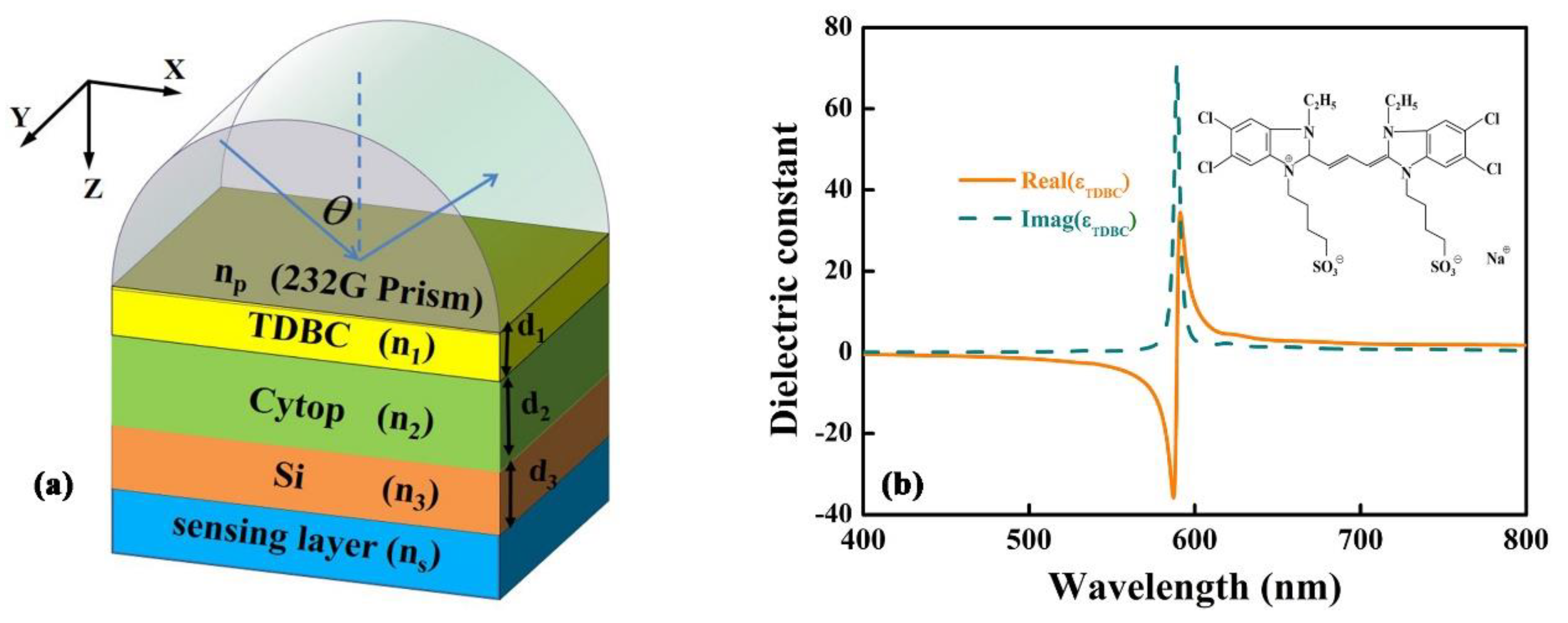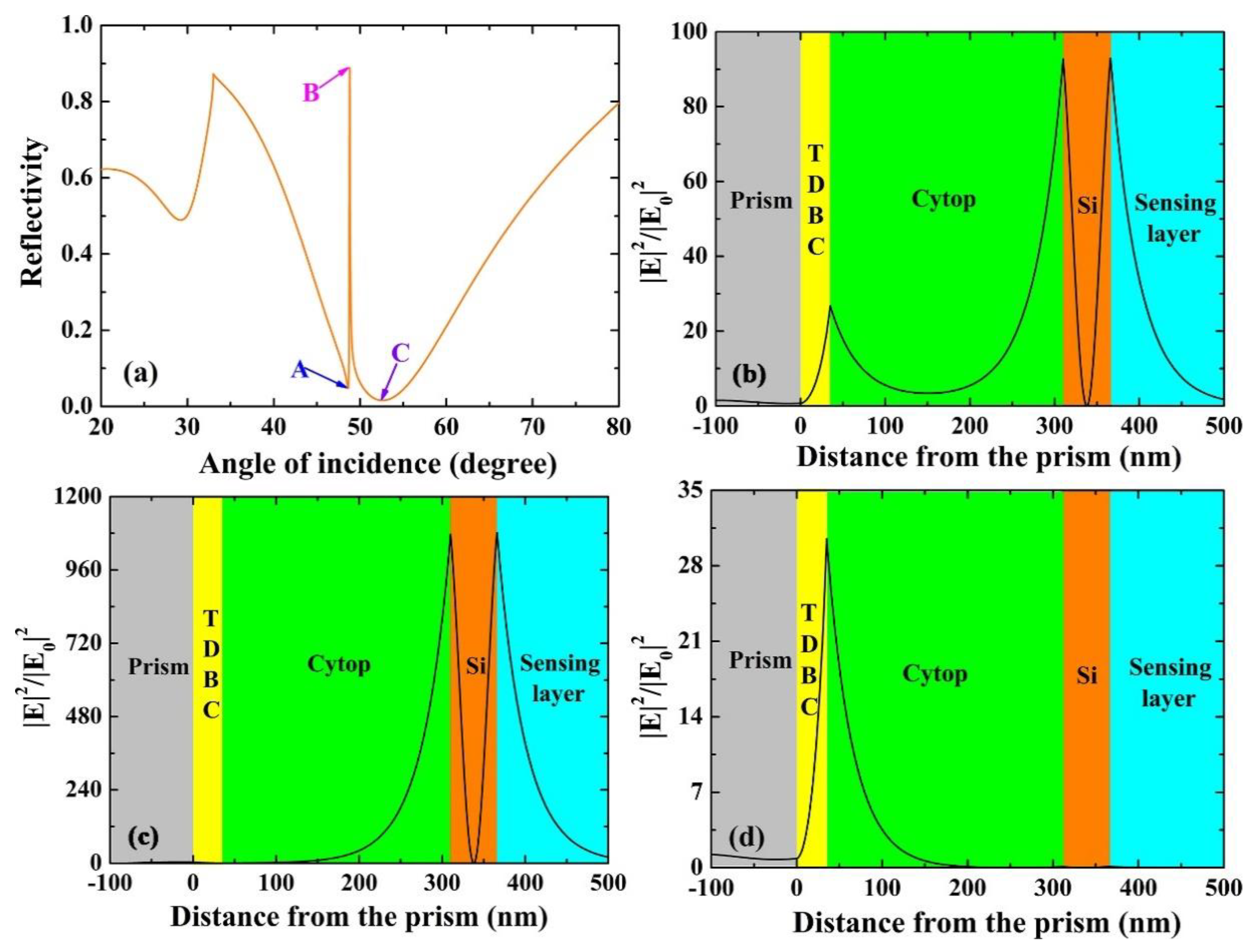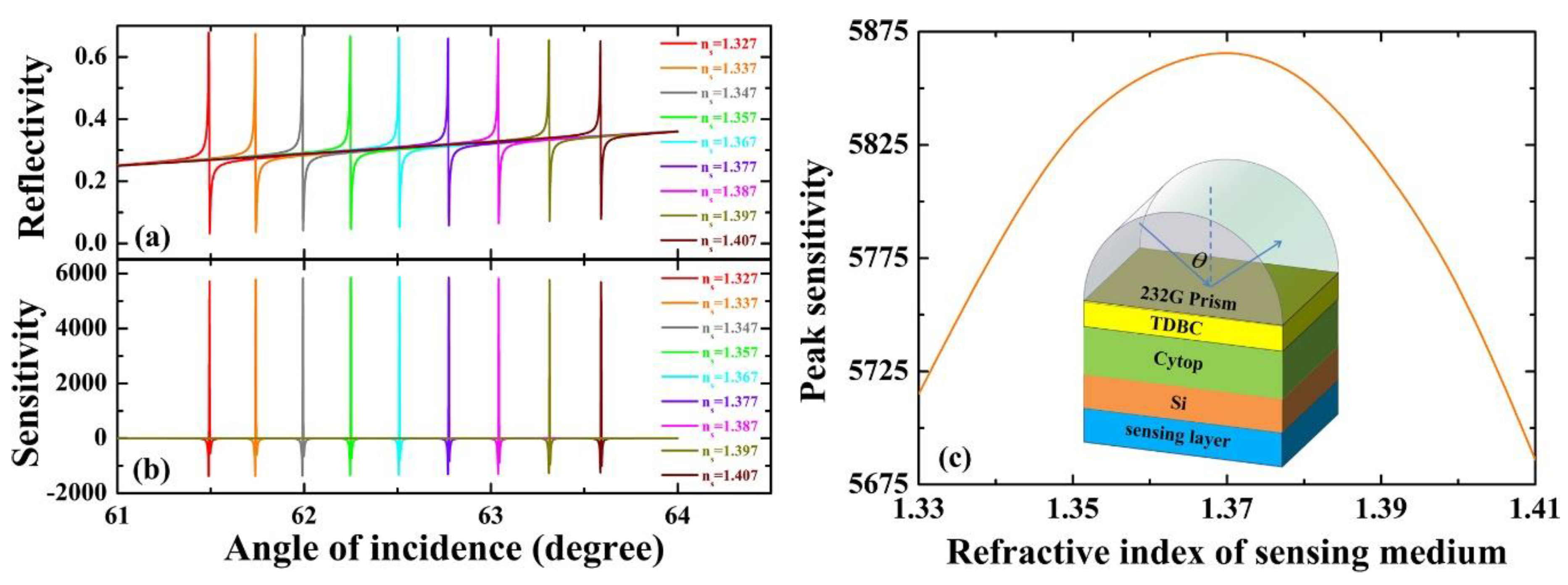Fano Resonance in Waveguide Coupled Surface Exciton Polaritons: Theory and Application in Biosensor
Abstract
:1. Introduction
2. Design Consideration and Theoretical Model
3. Results and Discussion
4. Conclusions
Author Contributions
Funding
Conflicts of Interest
References
- Ha, D.; Thuy, D.; Hoa, V.; Van, T.; Viet, N. On the theory of three types of polaritons (phonon, exciton, and plasmon polaritons). J. Phys. Conf. Ser. 2017, 865, 012007. [Google Scholar] [CrossRef]
- Barnes, W.L.; Dereux, A.; Ebbesen, T.W. Surface plasmon subwavelength optics. Nature 2003, 424, 824–830. [Google Scholar] [CrossRef] [PubMed]
- Kim, E.S.; Yong, M.K.; Choi, K.C. Surface-plasmon-assisted nano-lithography with a perfect contact aluminum mask of a hexagonal dot array. Plasmonics 2016, 1, 1337–1342. [Google Scholar] [CrossRef]
- Homola, J.; Yee, S.S.; Gauglitz, G. Surface plasmon resonance sensors: Review. Sens. Actuators B Chem. 1999, 54, 3–15. [Google Scholar] [CrossRef]
- Zheng, G.; Zhang, H.; Bu, L.; Gao, H.; Xu, L.; Liu, Y. Tunable Fano resonance in mid-infrared waveguide-coupled Otto configuration. Plasmonics 2018, 13, 215–220. [Google Scholar] [CrossRef]
- Zheng, G.; Chen, Y.; Bu, L.; Xu, L.; Su, W. Waveguide-coupled surface phonon resonance sensors with super-resolution in the mid-infrared region. Opt. Lett. 2016, 41, 1582–1585. [Google Scholar] [CrossRef] [PubMed]
- Takatori, K.; Okamoto, T.; Ishibashi, K.; Micheletto, R. Surface exciton polaritons supported by a J-aggregate-dye/air interface at room temperature. Opt. Lett. 2017, 42, 3876–3879. [Google Scholar] [CrossRef]
- Bonnand, C.; Bellessa, J.; Plant, J. Study of strong coupling between surface plasmon and exciton in an organic semiconductor. J. Non-Cryst. Solids 2006, 352, 1683–1685. [Google Scholar] [CrossRef]
- Pirotta, S.; Patrini, M.; Liscidini, M.; Galli, M.; Dacarro, G.; Canazza, G.; Guizzetti, G.; Comoretto, D.; Bajoni, D. Strong coupling between excitons in organic semiconductor and Bloch surface wave. Appl. Phys. Lett. 2014, 104, 051111. [Google Scholar] [CrossRef]
- Ellenbogen, T.; Steinvurzel, P.; Crozier, K. Strong coupling between excitons in J-aggregates and waveguide modes in thin polymer films. Appl. Phys. Lett. 2011, 98, 261103. [Google Scholar] [CrossRef]
- Rosenberg, J.; Shenoi, R.; Vandervelde, T.; Krishna, S.; Painter, O. A multispectral and polarization-selective surface-plasmon resonant midinfrared detector. Appl. Phys. Lett. 2009, 95, 161101. [Google Scholar] [CrossRef] [Green Version]
- Lu, H.; Liu, X.; Mao, D.; Wang, G. Plasmonic nanosensor based on Fano resonance in waveguide-coupled resonators. Opt. Lett. 2012, 37, 3780–9782. [Google Scholar] [CrossRef] [PubMed]
- Miroshnichenko, A.E.; Flach, S.Y.; Kivshar, S. Fano resonances in nanoscale structures. Rev. Mod. Phys. 2010, 82, 2257–2298. [Google Scholar] [CrossRef] [Green Version]
- Fano, U. Effects of configuration interaction on intensities and phase shifts. Phys. Rev. 1961, 124, 1866–1874. [Google Scholar] [CrossRef]
- Kaldun, A.; Ott, C.; Blattermann, A.; Laux, M.; Meyer, K.; Ding, T.; Fischer, A.; Pfeifer, T. Extracting phase and amplitude modifications of laser-coupled Fano resonances. Phys. Rev. Lett. 2014, 112, 103001. [Google Scholar] [CrossRef] [PubMed]
- Zheng, C.; Jia, T.; Zhao, H.; Xia, Y.; Zhang, S.; Feng, D.; Sun, Z. Theoretical study on narrow Fano resonance of nanocrescent for the label-free detection of single molecules and single nanoparticles. RSC Adv. 2018, 8, 3381–3391. [Google Scholar] [CrossRef] [Green Version]
- Zheng, C.; Liu, S.; Yang, W.; Zhu, Z. Coherent control of the Goos-Hanchen shift via Fano interference. J. Appl. Phys. 2016, 119, 143101. [Google Scholar] [CrossRef]
- Hao, Q.; Juluri, B.; Zheng, Y.; Wang, B.; Chiang, I.; Jensen, L.; Crespi, V.; Eklund, P.; Huang, T. Effect of intrinsic fano interference on surface-enhanced Raman spectroscopy: Comparison between platinum and gold. J. Phys. Chem. C 2010, 114, 18059–18066. [Google Scholar] [CrossRef]
- Guo, J.; Jiang, L.; Dai, X.; Xiang, Y. Tunable Fano resonances of a graphene/waveguide hybrid structure at az mid-infrared wavelength. Opt. Express 2016, 24, 4740–4748. [Google Scholar] [CrossRef]
- Baquedano, E.; Gonzalez, M.; Paniagua-Dominguez, R.; Sanchez-Gil, J.; Postigo, P. Low-cost and large-size nanoplasmonic sensor based on Fano resonances with fast response and high sensitivity. Opt. Express 2017, 25, 15967–15976. [Google Scholar] [CrossRef]
- Hayashi, S.; Nesterenko, D.; Sekkat, Z. Waveguide-coupled surface plasmon resonance sensor structure: Fano lineshape engineering for ultrahigh-resolution sensing. J. Phys. D Appl. Phys. 2015, 48, 325303. [Google Scholar] [CrossRef]
- Giannini, V.; Zhang, Y.; Forcales, M.; Rivas, J.G. Long-range surface polaritons in ultra-thin films of silicon. Opt. Express 2008, 16, 19674–19685. [Google Scholar] [CrossRef] [PubMed]
- Maharana, P.K.; Jha, R. Chalcogenide prism and graphene multilayer based surface plasmon resonance affinity biosensor for high performance. Sens. Actuators B-Chem. 2012, 169, 161–166. [Google Scholar] [CrossRef]
- Wu, L.; Guo, J.; Xu, H.; Dai, X.; Xiang, Y. Ultrasensitive biosensors based on long-range surface plasmon polariton and dielectric waveguide modes. Photonics Res. 2016, 4, 262–266. [Google Scholar] [CrossRef]
- Daimon, M.; Masumura, A. Measurement of the refractive index of distilled water from the near-infrared region to the ultraviolet region. Appl. Opt. 2007, 46, 3811–3820. [Google Scholar] [CrossRef] [PubMed]
- Gupta, B.; Sharma, A.K. Sensitivity evaluation of a multi-layered surface plasmon resonance-based fiber optic sensor: A theoretical study. Sens. Actuators B-Chem. 2005, 107, 40–46. [Google Scholar] [CrossRef]
- Wu, L.; Chu, H.S.; Koh, W.S.; Li, E.P. Highly sensitive graphene biosensors based on surface plasmon resonance. Opt. Express 2010, 18, 14395–14400. [Google Scholar] [CrossRef]
- Verma, R.; Gupta, B.; Jha, R. Sensitivity enhancement of a surface plasmon resonance based biomolecules sensor using graphene and silicon layers. Sens. Actuators B-Chem. 2011, 160, 623–631. [Google Scholar] [CrossRef]
- Ruan, B.; Guo, J.; Wu, L.; Zhu, J.; You, Q.; Dai, X.; Xiang, Y. Ultrasensitive terahertz biosensors based on Fano resonance of a graphene/waveguide hybrid structure. Sensors 2017, 17, 1924. [Google Scholar] [CrossRef]
- Wu, L.; Guo, J.; Wang, Q.; Lu, S.; Dai, X.; Xiang, Y.; Fan, D. Sensitivity enhancement by using few-layer black phosphorus-graphene/TMDCs heterostructure in surface plasmon resonance biochemical sensor. Sens. Actuators B-Chem. 2017, 249, 542–548. [Google Scholar] [CrossRef]
- Song, M.; Yu, H.; Wang, C.; Yao, N.; Pu, M.; Luo, J.; Zhang, Z.; Luo, X. Sharp Fano resonance induced by a single layer of nanorods with perturbed periodicity. Opt. Express 2015, 23, 2895–2903. [Google Scholar] [CrossRef] [PubMed]






© 2018 by the authors. Licensee MDPI, Basel, Switzerland. This article is an open access article distributed under the terms and conditions of the Creative Commons Attribution (CC BY) license (http://creativecommons.org/licenses/by/4.0/).
Share and Cite
Zhu, J.; Gan, S.; Ruan, B.; Wu, L.; Cai, H.; Dai, X.; Xiang, Y. Fano Resonance in Waveguide Coupled Surface Exciton Polaritons: Theory and Application in Biosensor. Sensors 2018, 18, 4437. https://doi.org/10.3390/s18124437
Zhu J, Gan S, Ruan B, Wu L, Cai H, Dai X, Xiang Y. Fano Resonance in Waveguide Coupled Surface Exciton Polaritons: Theory and Application in Biosensor. Sensors. 2018; 18(12):4437. https://doi.org/10.3390/s18124437
Chicago/Turabian StyleZhu, Jiaqi, Shuaiwen Gan, Banxian Ruan, Leiming Wu, Houzhi Cai, Xiaoyu Dai, and Yuanjiang Xiang. 2018. "Fano Resonance in Waveguide Coupled Surface Exciton Polaritons: Theory and Application in Biosensor" Sensors 18, no. 12: 4437. https://doi.org/10.3390/s18124437




